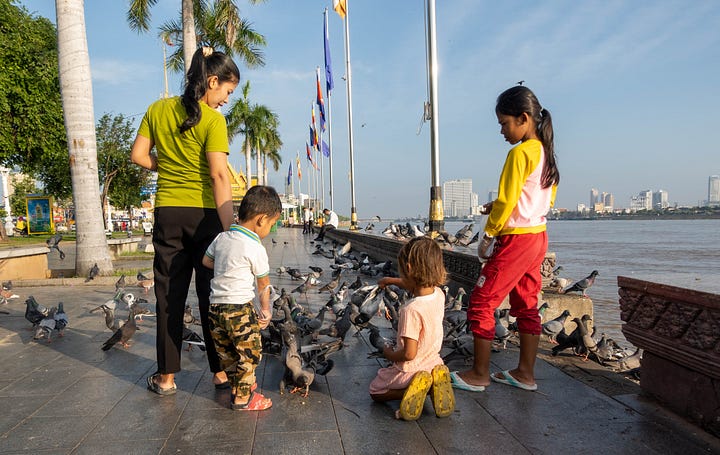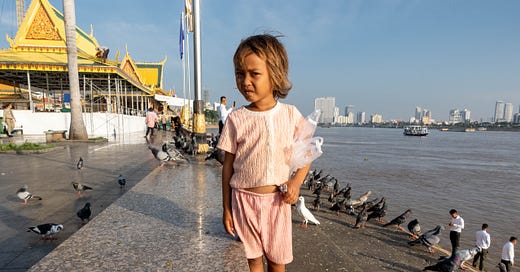The little girl pictured above runs a pigeon hustle: She sells bags of bird feed to the families that cluster on the boardwalk, and then when the hungry flocks surrounds the excited children, she grabs two birds by their tail feathers, holds them dangling from her tiny hands, and offers to release them for a fee, and for “good spirits.”
I don’t have a photo of her proudly (and gently) holding the pigeons upside down, because I didn’t want to reward an eight year old for that, although I admire her creativity and survival instinct, so I did pay her, something I rarely do, because of her situation.
Her hustle is unique, but learned, with other family members, and friends, working the same stretch of boardwalk, but with a more common way to make money: They capture sparrows with nets, collecting them in home made cages, which they bring to the nearby wats and shrines, where people pay for their release, again in the name of “good spirits.”


These bird hustlers, or Buddhism hustlers depending on how you look at it, have plenty of work, because there are both plenty of wats and also plenty of kids to sell bird feed to, because the two striking things about Phnom Penh is how young the city is, how many children there are running around, some feral like the pigeon hustlers, others clutching their parents hands pleading to feed the pigeons, and how many wats there are.
Like in Bangkok, the wats are aesthetically pleasing ornamental landmarks punctuating the otherwise chaotic, cluttered, and ugly monotony of Phnom Penh, offering a palliative to its tumult. Tranquil escapes from the swarms of motor scooters, tuk-tuks, hawkers, hustlers, food stalls, girlie bars, coffee stands, and Priuses that crowd the streets, alleys, and sidewalks beyond their gates.
Phnom Penh, also like Bangkok, is not enjoyable to walk in. Other than the river boardwalk, and the mile long park near my hotel on street 278th (in the more “refined” south of the city), walking means hugging the shoulder of a busy road as teenagers on mopeds and tuk-tuks zip past you, only a foot away, since the sidewalks are useless for pedestrians, used instead for parking and kiosks and stalls of every build.
The drivers however are considerate, and so you can navigate the city by employing an aggressive audacity — by forging ahead despite the oncoming swarm, holding your hand out to say stop, and then going for it, because drivers do stop, or at least swerve to miss you, and when they don’t at first, and come closer than either wants, they slow down and apologize profusely.
That style of walking is a technique I learned in Hanoi, and perfected in other big messy developing cities, like Kampala, where the rush of oncoming traffic is primarily pulsating mobs of motorcycles and mopeds which behave like a flock of birds, moving in an understood, but not voiced, order. Yet despite Cambodia being four times poorer than Vietnam, there are more cars here relative to mopeds1, which makes walking more dangerous, because it’s akin to adding a smattering of Pterosaurs to a flock of sparrows.




Yet despite those surface level similarities, and despite being half as rich as Bangkok, Phnom Penh is by far the more optimistic, buoyant, and effervescent city, and I am much happier here than I was in Bangkok, and that’s entirely due to its second defining feature — there are a lot of children running around.
Phnom Penh is a young city chock full of kids. They are everywhere, and they bring a positive energy, warmth, and joy that no amount of adult diversions — no amount of bars, casinos, exceptional cuisine, and museums — can replicate, because nothing warms the heart like a big smile from a tiny face. I don’t care how silly and maudlin that sounds, because it’s simply true, at an innate and an intellectual level. To be even more corny, being in a city of filled playgrounds is a lot more fulfilling, energizing, and uplifting, than being in a city of filled casinos.





